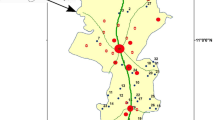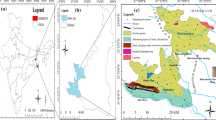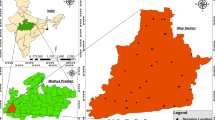Abstract
Fluoride contamination in groundwaters of a rural region in semi-arid Western India has been studied using combination of geochemical-and-isotopic techniques, in conjunction with Health Quotient assessment approach. The objective of this study is to determine the sources and controls on fluoride content and to evaluate probabilistic non-carcinogenic risk associated with its long-term consumption. F− ranges from 0.3 to 12 mg L−1, shows high spatial variability, and ~ 35% of the samples have F− > 1.5 mg L−1 (WHO maximum limit for drinking). Two sources are identified: high F− results from water–rock interaction of F-bearing minerals in granites and gneisses, while phosphate fertilizers can contribute up to ~ 0.46 mg L−1 of groundwater F− that can be significant for low F− samples. High F− samples are characterized by high pH, Na and alkalinity, and low Ca. Calcite precipitation drives the solubility of F-bearing minerals. Kinetic fractionation of water isotopes (18O and 2H) demonstrates that evaporation plays role in enriching groundwater F−. Non-carcinogenic risk, estimated by Hazard Quotient (\(HQ_{{{\text{oral}}}}^{{\text{F}}}\)), ranges from 0.13–5.72 to 0.26–11.86 for adult and children, respectively. Conservative estimate shows that ~ 0.467 million of adults and~0.073 million of children in four sub-districts are under the risk of fluorosis—while the residents of other five sub-districts remain safe from it. Finally, we suggest stakeholders to install F− treatment plants to ensure the health safety of local residents in the high-risk zones, create awareness in farmers for optimum use of fertilizers, and promote rainwater harvesting, for better management of groundwater resources and quality in the region.

reproduced from the geological map (Mehsana district) of Geological survey of India (GSI)





Similar content being viewed by others
Data Availability
All data were shown in the supporting information.
References
Adimalla, N., Li, P., & Qian, H. (2018). Evaluation of groundwater contamination for fluoride and nitrate in semi-arid region of Nirmal Province, South India: a special emphasis on human health risk assessment (HHRA). Human and ecological risk assessment: an international journal. https://doi.org/10.1080/10807039.2018.1460579
Ahada, C. P., & Suthar, S. (2019). Assessment of human health risk associated with high groundwater fluoride intake in southern districts of Punjab India. Exposure and Health, 11(4), 267–275. https://doi.org/10.1007/s12403-017-0268-4
Ali, S., Fakhri, Y., Golbini, M., Thakur, S. K., Alinejad, A., Parseh, I., & Bhattacharya, P. (2019). Concentration of fluoride in groundwater of India: A systematic review, meta-analysis and risk assessment. Groundwater for Sustainable Development, 9, 100224.
Apambire, W. B., Boyle, D. R., & Michel, F. A. (1997). Geochemistry, genesis, and health implications of fluoriferous groundwaters in the upper regions of Ghana. Environmental Geology, 33(1), 13–24. https://doi.org/10.1007/s002540050221
Ayoob, S., & Gupta, A. K. (2006). Fluoride in drinking water: a review on the status and stress effects. Critical Reviews in Environmental Science and Technology, 36(6), 433–487. https://doi.org/10.1080/10643380600678112
BIS. (2012). (Bureau of Indian Standards) IS:10500 Indian Standard for Drinking Water Specification. Second Revision.
CGWB, 2010. Groundwater quality in shallow aquifers of India.
CGWB, Faridabad, p 64.CGWB March 2014. District groundwater brochure Mahesana district, Gujarat.
Chae, G. T., Yun, S. T., Mayer, B., Kim, K. H., Kim, S. Y., Kwon, J. S., & Koh, Y. K. (2007). Fluorine geochemistry in bedrock groundwater of South Korea. Science of the Total Environment, 385(1–3), 272–283. https://doi.org/10.1016/j.scitotenv.2007.06.038
Chatterjee, J., & Singh, S. K. (2012). 87Sr/86Sr and major ion composition of rainwater of Ahmedabad, India: Sources of base cations. Atmospheric Environment, 63, 60–67. https://doi.org/10.1016/j.atmosenv.2012.08.060
Chidambaram, S., Ramanathan, A. L., & Vasudevan, S. (2003). Fluoride removal studies in water using natural materials. Water SA, 29(3), 339–344.
Clark, I. D., & Fritz, P. (1997). Environmental isotopes in hydrogeology. CRC Press.
Das, D. K., DK, D., GK, D. B., & AL, K. (1981). Chemical composition of monsoon rainwater over Bhopal, Madhya Pradesh (India) during 1977 and 1978.
Das, A., Krishnaswami, S., Sarin, M. M., & Pande, K. (2005). Chemical weathering in the Krishna Basin and Western Ghats of the Deccan Traps, India: Rates of basalt weathering and their controls. Geochimica et Cosmochimica Acta, 69(8), 2067–2084.
Datta, P. S., Deb, D. L., & Tyagi, S. K. (1996). Stable isotope (18O) investigations on the processes controlling fluoride contamination of groundwater. Journal of contaminant hydrology, 24(1), 85–96. https://doi.org/10.1016/0169-7722(96)00004-6
Deshpande, R. D., & Gupta, S. K. (2012). Oxygen and hydrogen isotopes in hydrological cycle: new data from IWIN national programme. Proceedings of the Indian National Science Academy, 78(3), 321–331.
Dey, R. K., Swain, S. K., Mishra, S., Sharma, P., Patnaik, T., Singh, V. K., & Patel, R. K. (2012). Hydrogeochemical processes controlling the high fluoride concentration in groundwater: a case study at the Boden block area, Orissa India. Environmental Monitoring and Assessment, 184(5), 3279–3291. https://doi.org/10.1007/s10661-011-2188-2
Dhiman, S. D., & Keshari, A. K. (2006). Hydrogeochemical evaluation of high-fluoride groundwaters: a case study from Mehsana District, Gujarat India. Hydrological Sciences Journal, 51(6), 1149–1162. https://doi.org/10.1623/hysj.51.6.1149
Dissanayake, C. B. (1991). The fluoride problem in the ground water of Sri Lanka—environmental management and health. International Journal of Environmental Studies, 38(2–3), 137–155.
Epstein, S., &Mayeda, T. (1953). Variation of O18 content of waters from natural sources. Geochimicaetcosmochimicaacta, 4(5): 213–224
Fuge, R., & Andrews, M. J. (1988). Fluorine in the UK environment. Environmental Geochemistry and Health, 10(3–4), 96–104. https://doi.org/10.1007/BF01758677
Guo, Q., Wang, Y., Ma, T., & Ma, R. (2007). Geochemical processes controlling the elevated fluoride concentrations in groundwaters of the Taiyuan Basin, Northern China. Journal of Geochemical Exploration, 93(1), 1–12. https://doi.org/10.1016/j.gexplo.2006.07.001
Gupta, S. K., Deshpande, R. D., Agarwal, M., & Raval, B. R. (2005). Origin of high fluoride in groundwater in the North Gujarat-Cambay region India. Hydrogeology Journal, 13(4), 596–605.
Handa, B. K. (1975). Geochemistry and genesis of Fluoride-Containing ground waters in India. Groundwater, 13(3), 275–281.
Hem, J. D. (1985). Study and interpretation of the chemical characteristics of natural water . Department of the Interior, US Geological Survey. 2254
Jacks, G., Bhattacharya, P., Chaudhary, V., & Singh, K. P. (2005). Controls on the genesis of some high-fluoride groundwaters in India. Applied Geochemistry, 20(2), 221–228. https://doi.org/10.1016/j.apgeochem.2004.07.002
Jha, S. K., Singh, R. K., Damodaran, T., Mishra, V. K., Sharma, D. K., & Rai, D. (2013). Fluoride in groundwater: toxicological exposure and remedies. Journal of Toxicology and Environmental Health, Part B, 16(1), 52–66. https://doi.org/10.1080/10937404.2013.769420
Karunanidhi, D., Aravinthasamy, P., Kumar, D., Subramani, T., & Roy, P. D. (2020). Sobol sensitivity approach for the appraisal of geomedical health risks associated with oral intake and dermal pathways of groundwater fluoride in a semi-arid region of south India. Ecotoxicology and environmental safety, 194, 110438.
Kazi, T. G., Brahman, K. D., Baig, J. A., & Afridi, H. I. (2018). A new efficient indigenous material for simultaneous removal of fluoride and inorganic arsenic species from groundwater. Journal of hazardous materials, 357, 159–167.
Kulkarni, V. N. (1985). Geology of Gujarat senior Geologist Engineering Research Institute. PWD.
Kumar, S., Venkatesh, A. S., Singh, R., Udayabhanu, G., & Saha, D. (2018). Geochemical signatures and isotopic systematics constraining dynamics of fluoride contamination in groundwater across Jamui district, Indo-Gangetic alluvial plains, India. Chemosphere, 205, 493–505. https://doi.org/10.1016/j.chemosphere.2018.04.116
Kundu, M. C., & Mandal, B. (2009). Assessment of potential hazards of fluoride contamination in drinking groundwater of an intensively cultivated district in West Bengal India. Environmental Monitoring and Assessment, 152(1–4), 97. https://doi.org/10.1007/s10661-008-0299-1
Kundu, N., Panigrahi, M., Tripathy, S., Munshi, S., Powell, M., & Hart, B. (2001). Geochemical appraisal of fluoride contamination of groundwater in the Nayagarh District of Orissa India. Environmental Geology, 41(3–4), 451–460. https://doi.org/10.1007/s002540100414
Li, C., Gao, X., & Wang, Y. (2015). Hydrogeochemistry of high-fluoride groundwater at Yuncheng Basin, northern China. Science of the Total Environment, 508, 155–165. https://doi.org/10.1016/j.scitotenv.2014.11.045
Maurya, A. S., Shah, M., Deshpande, R. D., & Gupta, S. K. (2009, November). Protocol for δ18O and δD analyses of water sample using Delta V plus IRMS in CF Mode with Gas Bench II for IWIN National Programme at PRL, Ahmedabad. In 11th ISMAS Triennial Conference of Indian Society for Mass Spectrometry . Indian Society for Mass Spectrometry Hyderabad 314, 314–317
Meenakhi,S., & Maheswari, R.C.(2006). Fluoride in drinking water and its removal. Journal of Hazardous Materials, 137(1): 456–463
Millar, G. J., Couperthwaite, S. J., Dawes, L. A., Thompson, S., & Spencer, J. (2017). Activated alumina for the removal of fluoride ions from high alkalinity groundwater: new insights from equilibrium and column studies with multicomponent solutions. Separation and Purification Technology, 187, 14–24.
Mukherjee, I., & Singh, U. K. (2018). Groundwater fluoride contamination, probable release, and containment mechanisms: a review on Indian context. Environmental geochemistry and health, 40(6), 2259–2301. https://doi.org/10.1007/s10653-018-0096-x
Mukherjee, I., Singh, U. K., & Patra, P. K. (2019). Exploring a multi-exposure-pathway approach to assess human health risk associated with groundwater fluoride exposure in the semi-arid region of east India. Chemosphere, 233, 164–173.
Ozsvath, D. L. (2009). Fluoride and environmental health: a review. Reviews in Environmental Science and Bio/Technology, 8(1), 59–79. https://doi.org/10.1007/s11157-008-9136-9
Podgorski, J. E., Labhasetwar, P., Saha, D., & Berg, M. (2018). Prediction modeling and mapping of groundwater fluoride contamination throughout India. Environmental Science & Technology, 52(17), 9889–9898. https://doi.org/10.1021/acs.est.8b01679
Raj, D., & Shaji, E. (2017). Fluoride contamination in groundwater resources of Alleppey, southern India. Geoscience Frontiers, 8, 117–124. https://doi.org/10.1016/j.gsf.2016.01.002
Ramteke, L. P., Sahayam, A. C., Ghosh, A., Rambabu, U., Reddy, M. R. P., Popat, K. M., & Ghosh, P. K. (2018). Study of fluoride content in some commercial phosphate fertilizers. Journal of Fluorine Chemistry, 210, 149–155. https://doi.org/10.1016/j.jfluchem.2018.03.018
Reddy, D. V., Nagabhushanam, P., Sukhija, B. S., Reddy, A. G. S., & Smedley, P. L. (2010). Fluoride dynamics in the granitic aquifer of the Wailapally watershed, Nalgonda District India. Chemical Geology, 269(3–4), 278–289. https://doi.org/10.1016/j.chemgeo.2009.10.003
Saxena, V., & Ahmed, S. (2001). Dissolution of fluoride in groundwater: a water-rock interaction study. Environmental Geology, 40(9), 1084–1087. https://doi.org/10.1007/s002540100290
Saxena, V., & Ahmed, S. (2003). Inferring the chemical parameters for the dissolution of fluoride in groundwater. Environmental Geology, 43(6), 731–736. https://doi.org/10.1007/s00254-002-0672-2
Schoeller, H. (1967). Geochemistry of groundwater—an international guide for research and practice. UNESCO.
Shaji, E., Viju, J., & Thambi, D. S. (2007). High fluoride in groundwater of Palghat District. Kerala. Current Science, 92(2), 240–245.
Shirke, K. D., Kadam, A., & Pawar, N. J. (2020). Health risk assessment and prevalence of fluoride in groundwater around the geological diversity of Ambadongar South Gujarat, India. Human and Ecological Risk Assessment: An International Journal, 1–20. https://doi.org/10.1080/10807039.2020.1858270.
Siddique, A., Nayak, A. K., & Singh, J. (2020). Synthesis of FeCl3-activated carbon derived from waste Citrus limetta peels for removal of fluoride: An eco-friendly approach for the treatment of groundwater and bio-waste collectively. Groundwater for Sustainable Development, 10, 100339.
Sreedevi, P. D., Ahmed, S., Madé, B., Ledoux, E., & Gandolfi, J. M. (2006). Association of hydrogeological factors in temporal variations of fluoride concentration in a crystalline aquifer in India. Environmental Geology, 50(1), 1–11. https://doi.org/10.1007/s00254-005-0167-z
Sudarshan, V., Srinivas, B., Shankar, S., Narsimha, A., Ravi Kumar, A., Geetha, S., & Ashok, K. (2016). Fluoride distribution in the groundwater of Gangadhara area, Karimnagar district, Telangana India. International Journal Earth Science Engineering, 9(2), 572–577.
Susheela, A. K. (1999). Fluorosis management programme in India. CurrSci, 77(10), 1250–1256.
The World Bank. 2010. Deep wells and prudence: Towards Pragmatic Action for addressing groundwater overexploitation in India.
Tewatia, R. K., & Chanda, T. K. (2017). Trends in fertilizer nitrogen production and consumption in India. The Indian Nitrogen Assessment (pp. 45–56). Elsevier.
Tiwari, A. N., Nawale, V. P., Tambe, J. A., & Satya Kumar, Y. (2008). Correlation of fluoride with bicarbonate in groundwater of exploratory wells in parts of Maharashtra. Journal of Applied Geochemistry, 10(1), 93–102.
Tiwari, K. K., Krishan, G., Prasad, G., Mondal, N. C., & Bhardwaj, V. (2020). Evaluation of fluoride contamination in groundwater in a semi-arid region, Dausa District, Rajasthan India. Groundwater for Sustainable Development, 11, 100465.
UNESCO-WWAP.2009.Statistics. International groundwater resources assessment centre.https://www.un-igrac.org/%0A.
UNICEF. (1999). States of the art report on the extent of fluoride in drinking water and the resulting endemicity in India. Report by fluorosis and rural development foundation for UNICEF.
Valsami-Jones, E., Ragnarsdottir, K. V., Putnis, A., Bosbach, D., Kemp, A. J., & Cressey, G. (1998). The dissolution of apatite in the presence of aqueous metal cations at pH 2–7. Chemical Geology, 151(1–4), 215–233.
WHO, G. (2011). Guidelines for drinking-water quality. World Health Organization, 216, 303-4.
Wu, J. C., Chen, S. S., Yu, T. C., Wu, K. C. W., & Hou, C. H. (2021). Effective electrochemically controlled removal of fluoride ions using electrodeposited polyaniline-carbon nanotube composite electrodes. Separation and Purification Technology, 254, 117561.
Acknowledgements
We thank Mr. Virendra Padhya for his technical support during water isotope analysis. Mr. Meet Panchal is thanked for his help in one of the campaigns. We thank the two anonymous reviewers for their constructive comments.
Funding
The study was funded by Department of Science and Technology, India (SR/FTP/ES-129/2009). Partial funding was made by Pandit Deendayal Petroleum University via Students’ Research Program (ORSP/R&D/SRP/2019/ARJB/029).
Author information
Authors and Affiliations
Contributions
RM and AD were involved in conceptualization. RM was also involved in sampling, methodology, data curation, visualization and writing-original draft. AD was involved in validation, writing and supervision. AS, SK, AD and RD were involved in reviewing the manuscript. AS and SK were involved in editing. SV, MG and RM contributed to the analysis.
Corresponding author
Ethics declarations
Conflict of interest
Authors declare that have no conflicts of interest.
Consent to participate
Not applicable.
Consent to publish
Not applicable.
Additional information
Publisher's Note
Springer Nature remains neutral with regard to jurisdictional claims in published maps and institutional affiliations.
Supplementary Information
Below is the link to the electronic supplementary material.
Rights and permissions
About this article
Cite this article
Mandal, R., Das, A., Sudheer, A.K. et al. Sources, controls, and probabilistic health risk assessment of fluoride contamination in groundwater from a semi-arid region in Gujarat, Western India: An isotope–hydrogeochemical perspective. Environ Geochem Health 43, 4043–4059 (2021). https://doi.org/10.1007/s10653-021-00894-2
Received:
Accepted:
Published:
Issue Date:
DOI: https://doi.org/10.1007/s10653-021-00894-2




